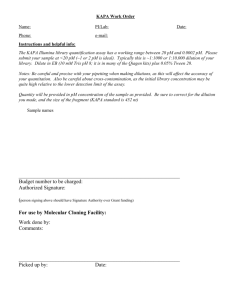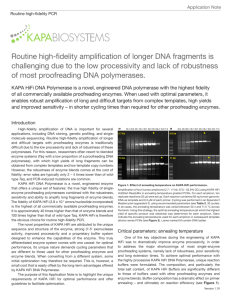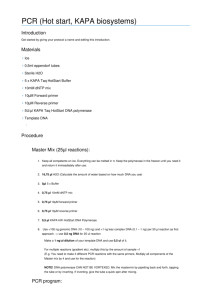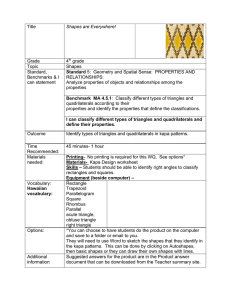Routine high-fidelity amplification of longer DNA fragments is
advertisement
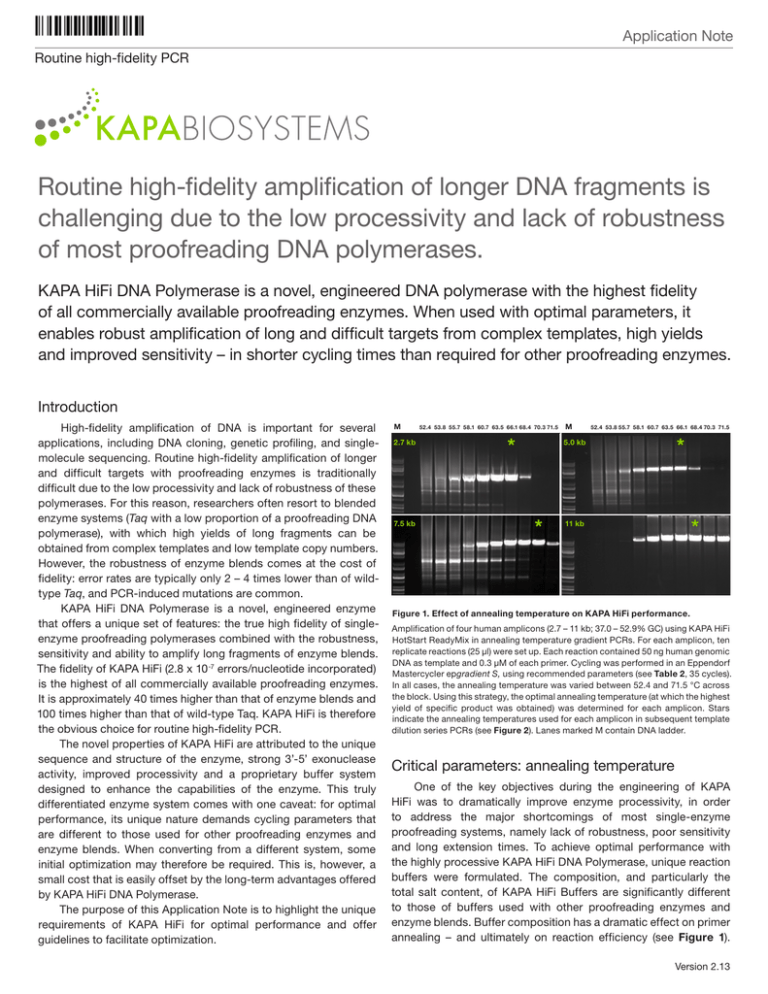
Application Note Routine high-fidelity PCR Routine high-fidelity amplification of longer DNA fragments is challenging due to the low processivity and lack of robustness of most proofreading DNA polymerases. KAPA HiFi DNA Polymerase is a novel, engineered DNA polymerase with the highest fidelity of all commercially available proofreading enzymes. When used with optimal parameters, it enables robust amplification of long and difficult targets from complex templates, high yields and improved sensitivity – in shorter cycling times than required for other proofreading enzymes. Introduction High-fidelity amplification of DNA is important for several applications, including DNA cloning, genetic profiling, and singlemolecule sequencing. Routine high-fidelity amplification of longer and difficult targets with proofreading enzymes is traditionally difficult due to the low processivity and lack of robustness of these polymerases. For this reason, researchers often resort to blended enzyme systems (Taq with a low proportion of a proofreading DNA polymerase), with which high yields of long fragments can be obtained from complex templates and low template copy numbers. However, the robustness of enzyme blends comes at the cost of fidelity: error rates are typically only 2 – 4 times lower than of wildtype Taq, and PCR-induced mutations are common. KAPA HiFi DNA Polymerase is a novel, engineered enzyme that offers a unique set of features: the true high fidelity of singleenzyme proofreading polymerases combined with the robustness, sensitivity and ability to amplify long fragments of enzyme blends. The fidelity of KAPA HiFi (2.8 x 10 -7 errors/nucleotide incorporated) is the highest of all commercially available proofreading enzymes. It is approximately 40 times higher than that of enzyme blends and 100 times higher than that of wild-type Taq. KAPA HiFi is therefore the obvious choice for routine high-fidelity PCR. The novel properties of KAPA HiFi are attributed to the unique sequence and structure of the enzyme, strong 3’-5’ exonuclease activity, improved processivity and a proprietary buffer system designed to enhance the capabilities of the enzyme. This truly differentiated enzyme system comes with one caveat: for optimal performance, its unique nature demands cycling parameters that are different to those used for other proofreading enzymes and enzyme blends. When converting from a different system, some initial optimization may therefore be required. This is, however, a small cost that is easily offset by the long-term advantages offered by KAPA HiFi DNA Polymerase. The purpose of this Application Note is to highlight the unique requirements of KAPA HiFi for optimal performance and offer guidelines to facilitate optimization. M 2.7 kb 7.5 kb 52.4 53.8 55.7 58.1 60.7 63.5 66.1 68.4 70.3 71.5 * M 52.4 53.8 55.7 58.1 60.7 63.5 66.1 68.4 70.3 71.5 5.0 kb * * * 11 kb Figure 1. Effect of annealing temperature on KAPA HiFi performance. Amplification of four human amplicons (2.7 – 11 kb; 37.0 – 52.9% GC) using KAPA HiFi HotStart ReadyMix in annealing temperature gradient PCRs. For each amplicon, ten replicate reactions (25 µl) were set up. Each reaction contained 50 ng human genomic DNA as template and 0.3 µM of each primer. Cycling was performed in an Eppendorf Mastercycler epgradient S, using recommended parameters (see Table 2, 35 cycles). In all cases, the annealing temperature was varied between 52.4 and 71.5 °C across the block. Using this strategy, the optimal annealing temperature (at which the highest yield of specific product was obtained) was determined for each amplicon. Stars indicate the annealing temperatures used for each amplicon in subsequent template dilution series PCRs (see Figure 2). Lanes marked M contain DNA ladder. Critical parameters: annealing temperature One of the key objectives during the engineering of KAPA HiFi was to dramatically improve enzyme processivity, in order to address the major shortcomings of most single-enzyme proofreading systems, namely lack of robustness, poor sensitivity and long extension times. To achieve optimal performance with the highly processive KAPA HiFi DNA Polymerase, unique reaction buffers were formulated. The composition, and particularly the total salt content, of KAPA HiFi Buffers are significantly different to those of buffers used with other proofreading enzymes and enzyme blends. Buffer composition has a dramatic effect on primer annealing – and ultimately on reaction efficiency (see Figure 1). Version 2.13 Application Note Routine high-fidelity PCR The optimal annealing temperature for any primer pair will be higher in KAPA HiFi Buffers than when the same primer pair is used in a different buffer. When a suboptimal (too low) annealing temperature is used with KAPA HiFi, the reaction product is typically dominated by non-specific amplicons, with a very low yield or absence of the target fragment. To obtain robust amplification of particularly longer amplicons, it is imperative to use an annealing temperature that is optimal for the specific primer pair in the KAPA HiFi Buffer system. To determine this optimal annealing temperature, two approaches are recommended: • determine the optimal annealing temperature in an annealing temperature gradient PCR, or • set up several replicate reactions, and perform the PCR using different annealing temperatures in the range of 65 – 72 °C (e.g. in increments of 1.0 – 2.5 °C). For other parameters to be used during the optimization of the annealing temperature, please refer to Tables 1 and 2. Table 1. KAPA HiFi reaction setup for routine high-fidelity PCR. Reaction component1 PCR grade water 5X KAPA HiFi Fidelity or GC Buffer2 10 mM dNTP Mix 10 µM Forward primer Final conc. Per 25 µl reaction - Up to 25.0 µl 1X 5.0 µl 0.3 mM each dNTP 0.75 µl 0.3 µM 0.75 µl M Template DNA 1 U/µl KAPA HiFi or KAPA HiFi HotStart DNA Polymerase 0.3 µM 0.75 µl 10 – 50 ng - 0.5 U/reaction 0.5 µl The same reaction parameters are recommended for KAPA HiFi HotStart ReadyMix. If the ReadyMix is used, replace the 5X buffer, dNTPs and polymerase with 12.5 µl 2X ReadyMix per 25 µl reaction and adjust the volume of water. KAPA HiFi HotStart ReadyMix contains Mg2+ at a 1X concentration of 2.5 mM. 2 Both KAPA HiFi Buffers contain Mg2+ at a 1X concentration of 2 mM. This may be increased to achieve optimal yields and sensitivity. For every additional 0.5 mM Mg2+ (1X concentration), add 0.5 µl of the 25 mM MgCl2 solution supplied in the kit, per 25 µl reaction. Cycling step Initial denaturation Denaturation 1 2 – 5 min at 95 °C 20 sec at 98 °C Annealing 15 sec at optimal Ta Extension1 15 – 30 sec/kb at 72 °C Final extension 1 Temperature & time x 25 – 35 cycles 1 – 5 min at 72 °C 1 Use 15 sec/kb for amplicons ≤1 kb. For longer amplicons, 30 sec/kb is recommended. Technical support: support@kapabiosystems.com Ordering information: sales@kapabiosystems.com 2 0.4 50 10 2 5.0 kb 0.4 50 10 2 7.5 kb 0.4 50 10 2 0.4 11 kb Figure 2. KAPA HiFi allows for robust and sensitive, routine high-fidelity amplifcation of long DNA fragments from complex templates. Amplification of four human amplicons (2.7 – 11 kb; 37.0 – 52.9% GC) using KAPA HiFi HotStart ReadyMix (top) or Phusion® High-Fidelity DNA Polymerase (Finnzymes, bottom), in template dilution series PCRs. Reactions (25 µl) were set up according to each manufacturer's recommendations and contained 50 ng, 10 ng, 2 ng or 400 pg human genomic DNA as template. Cycling was performed in an Eppendorf Mastercycler epgradient S, using the parameters recommended for each enzyme system. The optimal annealing temperature for each amplicon and enzyme system was determined as shown in Figure 1. Lanes marked M contain DNA ladder. Conclusion Once the optimal annealing temperature for a specific primer pair in a KAPA HiFi reaction has been determined, very little additional optimization should be required to achieve robust and sensitive amplification. However, the following recommendations must be adhered to for optimal performance: • • 1 Table 3. KAPA HiFi cycling parameters for routine high-fidelity PCR. 10 2.7 kb • 10 µM Reverse primer 50 • Use the minimum number of PCR cycles. This ensures optimal fidelity and specificity of amplification. If smearing occurs, reduce the number of cycles to 35 or less. Do not use too much DNA. For most applications, 10 – 50 ng per 25 µl reaction (or equivalent) should be sufficient. More DNA can lead to reduced yields and/or non-specific amplification. Initial denaturation must be performed at 95 °C for 2 – 5 min (depending on template complexity and GC content), but denaturation in each cycle must be performed for 20 sec at 98 °C. This is necessary to ensure complete denaturation of accumulating amplification product in high-salt KAPA HiFi Buffers, and maximum reaction efficiency. Always dilute and store DNA and primers in 10 mM Tris-HCl (pH 8.0 – 8.5) or TE to preserve their integrity. Robust and sensitive amplification of longer fragments from nicked or degraded DNA, or using low quality primers, is not feasible. For more information on reaction setup, cycling parameters and optimization, please consult the KAPA HiFi, KAPA HiFi HotStart or KAPA HiFi HotStart ReadyMix Technical Data Sheets, or the KAPA HiFi FAQs, which are available at www.kapabiosystems.com.
